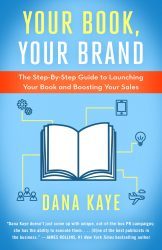Guest Post: Unlocking The Secrets To Email Marketing For Authors by Dana Kaye
Book publicity doesn’t have to be a mystery—not when Dana Kaye is around! Today, Dana is here on WFW sharing an excerpt from YOUR BOOK, YOUR BRAND, about email marketing for authors. It’s never too soon (or too late) to get started! So off I go…
Amy xo
Get In Your Reader’s Inbox: How To Utilize E-Mail Marketing
By Dana Kaye
 Email marketing is one of the most overlooked promotion tools authors have at their disposal, especially if you’re marketing to an older crowd. Not everyone is on Twitter, or spends a lot of time on Facebook, or reads the news online. But almost everyone, about 86.5% of the US population according to Internet Live Stats, has an email address. They may rarely use it, but if an email is in their inbox, they’ll see it, unlike Twitter and Facebook posts, which often get lost in the shuffle.
Email marketing is one of the most overlooked promotion tools authors have at their disposal, especially if you’re marketing to an older crowd. Not everyone is on Twitter, or spends a lot of time on Facebook, or reads the news online. But almost everyone, about 86.5% of the US population according to Internet Live Stats, has an email address. They may rarely use it, but if an email is in their inbox, they’ll see it, unlike Twitter and Facebook posts, which often get lost in the shuffle.
Services
There are a few email marketing services, some are free and some cost a small amount for every send. The one we use the most often is Mailchimp. It’s easy to use, highly customizable, and free if your mailing list is under 2,000 subscribers. There is also TinyLetter, which happens to be a spin-off of Mailchimp, which is an emailing service that is more personal and has fewer business features and analytics. Many authors say they prefer TinyLetter because it feels more personal and less like blatant self-promotion. Other services include Constant Contact and Vertical Response, both of which are paid services (usually pay-per-email sent) and a bit more difficult to customize. Some users report their emails are less likely to get caught in spam with the services Constant Contact or Vertical Response than with Mailchimp, but I haven’t had the experience of my Mailchimp messages being flagged as spam.
Building a List
Once you decide which service works best for you, sign up, create a list, and prepare a sign-up form. Add the newsletter sign-up form to your website and Facebook page (most have a Facebook integration tool that makes it easy). Once a month or so, remind your Twitter followers to sign up for your newsletter and include a link. I also advise authors to roll it in with a contest—maybe everyone who signs up before a certain date will receive a signed bookmark and bookplate, or one lucky winner will receive an Amazon gift card. Whatever it is, hosting a contest will encourage people to sign up and you’ll grow your list much faster.
Technically, people have to sign up for your mailing list themselves; you’re not allowed to add people without their permission. Many authors will stick to that rule; others will ignore it completely and add every person they ever met or swapped business cards with to their mailing list. I believe the ideal approach is somewhere in the middle.
Create a spreadsheet of friends and family members you think will be interested in receiving your newsletter and won’t be offended when it arrives in their inbox. Add any fans that have written you expressing interest in your work. If there are authors who have emailed you asking for a blurb or to read their manuscript or to connect them with your agent, add them to your list. My rule of thumb is that if they’ve expressed interest in you and your work, or if they’ve asked you for professional assistance, and they aren’t likely to get offended by receiving an email from you, add them. They can unsubscribe if they want.
Do not add book critics who have reviewed your book, but have never written you separately. Don’t add people you met at conferences and never corresponded with except to say, “Nice meeting you.” If they wouldn’t know you by name, they don’t belong on your list.
Many of you won’t feel comfortable doing that, and that’s fine. But most of us in the industry expect to be added to authors’ mailing lists, especially if we’ve written them in the past. To be honest, sometimes it’s a nice surprise. If I meet an author at a conference, get their card, and email them to say, “Nice meeting you” or “I loved your latest book,” I won’t always go to their website and seek out a newsletter sign up. But if they add me and they don’t send too many e-blasts, I definitely won’t unsubscribe and I am grateful for the reminder when they have a new book out.
When to Send and What to Say
When it comes to figuring out frequency of emails and what to include in each, a lot of it is common sense: don’t send emails every day, don’t be overly promotional, and don’t only send when you have a book out, but don’t send emails when you really have nothing to say. There are a few different ways to execute email marketing effectively, but whatever you decide, I recommend sticking with it and remaining consistent. If you decide to send semi-monthly or quarterly newsletters, stick with that schedule. If you only send 3 emails a year when you’re gearing up for a book launch, maintain that. Don’t change it dramatically just because you have a book out or there’s an initiative your publisher wants to promote. You train readers to know what to expect from you, and if you deviate too far from that expectation, you’ll lose subscribers.
If you write multiple books a year, publish in multiple arenas, or just have a lot going on that would interest your subscribers, then I recommend a quarterly or semi-monthly newsletter. This will allow you to connect with your readers on a regular basis and provide new and interesting information with each email. If you write one book a year or less, and that’s really the main focus of your email marketing, then you can opt to send 2–3 newsletters around your book launch, and that’s it. For this, I recommend sending one 8 weeks out, one 4 weeks out, then one on launch day.
When scheduling an email marketing campaign, you also want to consider the date, day of the week, and time it’s going out. About half of your subscribers will check their email at work, probably after they’ve cleared their professional inboxes. The other half will check it before they start their workday or in the evening when they return home. People’s inboxes are the fullest on Monday morning and emails sent on Friday afternoon are often overlooked. You want to pick the optimal time for people to open and read your content, rather than when they’re more likely to just delete the email because they’re pressed for time and overwhelmed by the amount in their inbox.
I used to always send emails mid-day, thinking that people are less likely to delete messages when their inboxes have been cleared. But a recent study conducted by Boomerang for Gmail revealed that email is 30% more likely to be opened if it’s sent between 6:00 and 7:00am. I started using this tact in our own newsletters, and right away, we noticed an increase in open rates. I attribute this to the type of content we’re sending; recipients may be more inclined to read a newsletter while they’re brushing their teeth, waiting for the train, or having their first cup of coffee. Wait too long and they’ve already started their day. They don’t have time to read about your upcoming book.
I usually send emails Tuesdays–Thursdays, unless Monday or Friday is a holiday, in which case I send on Wednesday. Lastly, you want to avoid sending e-blasts during the week of spring break, Thanksgiving break, or other times of the year when people travel. Your message will likely get buried under the rest of unwanted and non-emergency emails, and eventually deleted.
The content of the newsletters will vary depending on the schedule, but the key rule is the same: be consistent. If your newsletters always include some personal anecdotes, photos from research trips, little known facts about the region you write about, etc., then keep that up. Some authors, like Susan Dennard, opt to send a more service-based newsletter that includes writing tips, prompts, and publishing information. If you prefer to keep it about the book, that’s fine too. But it’s awkward, not to mention jarring, for your readers to transition from writing humorous, anecdotal, first-person emails about your recent research trip to an all-business, straight–book-information type email.
If you’re opting for the “only around the book launch” schedule, then I recommend including the following content in each newsletter:
Newsletter #1 (8 weeks prior to publication day): A synopsis of the upcoming book, buy links, any early reviews, and tour dates.
Newsletter #2 (4 weeks prior): Latest reviews of the book, a sample chapter or excerpt, tour schedule, buy links.
Newsletter #3 (launch day): A simple announcement that the book is out, with buy links. Keep it short and sweet.
If you’re aiming for more of an anecdotal or service-based newsletter, you’ll still want to send out a launch day announcement with links to buy the book. Since you wouldn’t have sent the previous two promotional newsletters listed above, I recommend including the tour dates, reviews, and an excerpt if available.
For all email blasts sent, you should ask yourself the question, “What benefit is the recipient getting from my newsletter?” The answer to that question should not be the privilege of receiving information about your book. Maybe it’s writing tips or advice. Maybe it’s extra content unavailable to the general public. In our newsletters, we give away free books with every blast. Whatever it is, there should be some tangible benefit for subscribing to your list. No one would sign up to receive an advertisement in their inbox each month.
This content was excerpted from Your Book, Your Brand: The Step-By-Step Guide to Launching Your Book and Boosting Your Sales, with permission from Dana Kaye and Diversion Books.
 Dana Kaye is the owner of Kaye Publicity, Inc. and author of Your Book, Your Brand: The Step-By-Step Guide to Launching Your Book and Boosting Your Sales. Known for her innovative ideas and knowledge of current trends, she frequently speaks on the topics of social media, branding, and publishing trends, and teaches online courses at KayePublicity.teachable.com.
Dana Kaye is the owner of Kaye Publicity, Inc. and author of Your Book, Your Brand: The Step-By-Step Guide to Launching Your Book and Boosting Your Sales. Known for her innovative ideas and knowledge of current trends, she frequently speaks on the topics of social media, branding, and publishing trends, and teaches online courses at KayePublicity.teachable.com.
Women's Fiction Writers
- Amy Sue Nathan's profile
- 543 followers



